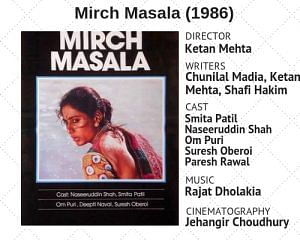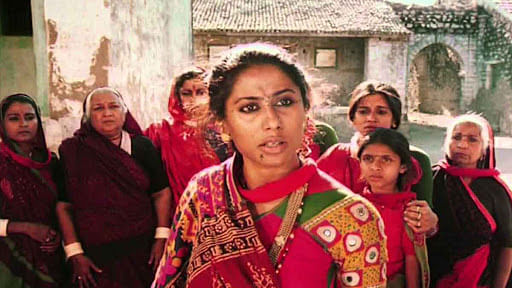Smita Patil left an indelible impact with her unique sensuality, resolve and vulnerability in Mirch Masala.
Any list of great Indian female lead performances will definitely feature Smita Patil’s feisty rebel Sonbai from Mirch Masala (1986). Last Thursday was Patil’s 32nd death anniversary.
Over the past one year, a tremendous shift has taken place in how the world views sexual assault and abuse of power after the #MeToo movement.
 Watching Mirch Masala after 32 years, Ketan Mehta’s NFDC-produced drama can be seen as a prototype of the global movement in some ways. Premised on the same idea of solidarity, where women form a support system for each other due to shared trauma, Mirch Masala was crystal in its depiction of wounded women who rise together.
Watching Mirch Masala after 32 years, Ketan Mehta’s NFDC-produced drama can be seen as a prototype of the global movement in some ways. Premised on the same idea of solidarity, where women form a support system for each other due to shared trauma, Mirch Masala was crystal in its depiction of wounded women who rise together.
Based on a short story by Chunilal Madia, Mirch Masala is a story about oppression – of a subedar on a village in pre-Independence Rann of Kutch; of a village chief on his wife and other young women in the village; of a father on his young daughter; and of the colonial system on a poor nation and its people.
True to its theme and slow-burn narrative style, the film begins with an establishing shot of the barren landscape, setting the tone for all that’s to come.
Also read: Padosan is a film that can’t be made in today’s Republic of Easy Offended India
Subedar (Naseeruddin Shah) has an eye on any and every woman of the village. In his first interaction at the riverbank with Sonbai, a village woman, the subedar sees her confident demeanour in the face of adversity and immediately takes notice. It’s that first impression that creates trouble for Sonbai, whose husband leaves for the city soon after.
As subedar’s lust consumes several houses in the village, Sonbai’s turn comes too. But unlike others, Sonbai, even in a moment of utter panic, slaps the subedar when he makes an obnoxious advance. Shocked at her defiance, subedar leaves his men after her.
In the ensuing tense chase, as the men look to hunt Sonbai, Mehta fills the frames with haunting images – mounds and mounds of red chillies, and a woman escaping what seems inevitable.
Mehta differentiated his filmmaking from his parallel cinema peers, all of whom had clear ideological leanings, with remarkable visual poetry – amply in evidence here, aided by Rajat Dholakia’s folk-based score that breathes life into a breathless chase.
Sonbai escapes to a chilli factory where a Muslim village elder, Abu Mian (Om Puri), offers her refuge, along with other women working there. When the subedar’s men ask him to return her to them, Mian refuses outright and vows to protect her space – he keeps the vow till his last breath.
(In Madia’s story, it was a tobacco factory. During a visit to Gujarat, Mehta’s favourite haunt since his breakout debut Bhavni Bhavai (1980), the director saw mounds of red chillies. The story and images coalesced together to form what became Mirch Masala.)
Also read: Long before India’s #MeToo, Pati Patni Aur Woh thought workplace harassment was funny
Pressure mounts on Sonbai to give up her agency on her body, even by women around her, but she doesn’t relent except for a brief moment. All this sets the stage for the climactic sequence where the subedar marches to the factory himself, seeking to forcibly take the woman who was denied to him.
The stunning sequence, in the 30 years since, is one of the most iconic climaxes in cinema. Earlier this year, visual stylist, auteur and fellow Gujarati Sanjay Leela Bhansali made Padmaavat, another story of defiance in the face of odds, and paid a rich tribute to Mehta’s overwhelming images.
Once Mian falls to a bullet and subedar walks towards Sonbai, while villagers wait for the inevitable capture, she waits for him with a sickle in her hand. But her courage breeds resistance in women who have in the past been devoured by the subedar’s power, and two of them rush towards subedar to blind him with red chilli powder. The film closes on the fiery eyes of Sonbai.
In a parallel multi-starrer cinema of sorts, surrounded by credible performers, Patil left an indelible impact with her unique sensuality, resolve and vulnerability. Few have matched up to her performance, even in the same space.
In his later projects, Mehta too has been unable to recreate the lyrical quality of Mirch Masala, which stood out for its folk tale-like narration of a story of oppression and resistance – themes that may resonate in the post-#MeToo world more than ever before. But he did create a shade of the colour ‘red’ that will always be associated with Mirch Masala. Even Bhansali would agree.
Also read: MJ Akbar: The brilliant editor who’s now seen as India’s most high-profile sexual predator






